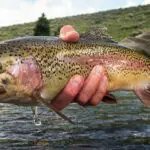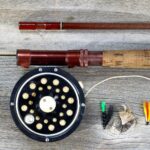Whether you’re a seasoned professional or a beginner just starting out, every angler has to learn how to tie a fishing hook to a line.
Arguably, the most important skill to master, using an effective knot to tie your hook to your line gives you a better chance of catching fish. If you don’t know how to tie an effective knot, you risk losing your catch.
![How To Tie A Fishing Hook To A Line? [Quickly And Easily]](https://irvinelake.net/wp-content/uploads/2022/04/How-To-Tie-A-Fishing-Hook-To-A-Line-Quickly-And-Easily.jpg)
Luckily, there is a wide range of strong and effective knots we can use to tie a fishing hook to a line.
For example, there’s the double overhand knot that has two loops and the fisherman’s hitch which can connect your line to another.
In this post, we are going to show you exactly how to tie a fishing hook to a line using different types of knots. We’ll also show you some of the most important things to remember when doing so.
If you want to learn a new way to tie your fishing hooks to a line or simply need to learn the basics, be sure to keep reading!
Tying Your Fishing Hooks To A Line
To be able to successfully tie your fishing hooks to a line, you need to understand a number of important things. For starters, you need to have a good knowledge of fishing knots.
Each knot has a different purpose, therefore, you need to know which knot to use and when. Further down this post, we will look at the most important types of knots in more detail.
Secondly, there are a number of basic rules you need to follow in order to successfully tie the knot. This refers to the skills you require to tie the knot, and also what it takes to effectively tie the knot every time.
We’ll look at what it takes to tie an effective knot first!
The Key To Success Is Patience
One of the most important things to do when tying a fishing hook to a line is to stay patient.
Tying your fishing hook to a line isn’t an easy process, even when conditions are perfect. The lines are thin, the eyes of the hooks are tiny, and the knots are small.
Add in shaky hands, cold weather, and blustery conditions, and things can get frustrating very quickly.
To tie a strong knot, you have to stay patient and remember that you won’t master the skill overnight. Before you become an expert, you’ll have to develop your skills and try a number of variations.
You’ll only get through the process successfully if you take your time and remain calm.
Practice Makes Perfect
The only way an angler can be successful when tying a fishing hook to a line is by mastering a variety of knots. As a result, you’re going to need to practice a lot.
On top of that, you’ll also need to practice under different circumstances and conditions. By practicing during the day in warm weather, you’ll start to understand how it feels to tie a knot in perfect conditions.
By then practicing at the end of the day in cold weather, you can begin to understand how to tie a knot when visibility is low and your hands are freezing.
If you don’t prepare in this way, you could be left in a situation you weren’t expecting.
It is also important for anglers to practice using different materials. Anglers don’t always use the same line and fishing hooks, so the only way to adjust for each scenario is to practice.
By practicing with different lines and hooks, you will be able to tackle a change of equipment quickly and easily.
Use The Correct Knot
When tying your fishing hook to your line, you should make sure you always use the right knot.
There are a lot of knots to choose from which can make things tricky, but by improving your knowledge about each type of knot and what it is best for, you should be fine.
A good starting point for beginners is to start by developing an improved knowledge of the fisherman’s knot.
Also referred to as the bowline knot, the fisherman’s knot is considered to be one of the best knots for tying a hook to a fishing line.
The knot consists of three parts. Those are the eyelet, loop, and slipknot. It is the eyelet where this knot starts. The slipknot is the part of the knot that goes through the eyelet.
Finally, the knot’s loop comes around the slipknot.
The bowline knot requires practice and patience, but when done correctly offers great performance. Once you’ve mastered this knot, you’ll have no issues tying other knots in the future. Just remember to practice!
Understand Free Line
Something often overlooked, especially by beginners, is the free line left hanging from the knot. No matter who they are, anglers are always left with a little bit of free line after tying a knot.
Beginners usually have more until they start to master each knot. This free line needs to be cut off. To do so, carefully cut the free line without damaging your knot. This is normally pretty easy.
Another aspect of free line beginners need to adjust to is using the right amount of line. It isn’t uncommon for beginners to use a piece of line that is too short.
This can result in the line not being long enough to finish the knot. Sadly, if this happens, the only solution is to untangle what you’ve already done and start again.
This can be avoided by practicing regularly. Over time, you’ll start to understand just how much line you need.
Tying Your Fishing Hook To A Line – The Best Knots
Now you know more about what it takes to tie an effective knot, we can start to look at the best knots to learn.
In this part of the post, we will take you through the most popular, quickest, and easiest knots you can learn and tell you exactly what to do.
By mastering the knots we look at, you will soon be able to effortlessly tie your fishing hooks to your line.
Let’s take a look!
The Fisherman’s Knot
The fisherman’s knot is by far the most commonly used knot when it comes to tying a fishing hook to a fishing line.
![How To Tie A Fishing Hook To A Line? [Quickly And Easily]](https://irvinelake.net/wp-content/uploads/2022/04/How-To-Tie-A-Fishing-Hook-To-A-Line-Quickly-And-Easily-1.jpg)
Aside from being relatively easy to tie, this knot is also popular because it can be used to tie a lure or swivel too.
For beginners, if there is only one knot you ever master, it has to be this one.
To tie a fisherman’s knot, pull your line through your hook’s eyelet. Wrap the lines loose end around the line 5 or 6 times. You should then pull the lines loose end through your first loop.
This will be the closest loop to your hook.
As you do this, pull at both ends to tighten your knot.
Square Knot
The square knot is another popular fishing knot. Used by experienced anglers and beginners, this knot is super easy to tie, only taking a couple of seconds to finish.
To tie this knot, take a square shape with both ends of your fishing line and bring them together. Next, push them down towards the middle of your square.
Make sure each end of the line goes through your loop. That is all it takes to tie the square knot.
Half Hitch Knot
The next knot is quite similar to the fisherman’s knot. It can be used to easily connect one piece of line to another.
Simply grab one piece of your line and pass it over the second part of the line. To complete the knot, all you have to do is pull both sections of rope. This will bring the two together, creating a tight knot.
Overhand Knot
This knot is typically used for creating loops in rope. As far as knots go, it is one of the simplest to learn.
All you have to do to tie the knot is place your thumb under your rope, pass it up to your index finger, and finish by wrapping the rope around your fingers.
Palomar Knot
Next up, we have the Palomar knot. The Palomar knot is a great option for anglers fishing using braided lines. It also happens to be one of the strongest knots around when it comes to tying a fishing hook to a line.
To tie the Palomar knot, start by taking your line and bending it in half to form a loop. Next, pull your loop through the hook eye. Then, using the line, tie an overhand knot. Keep it nice and loose.
You should then pull your loop over the end of your hook. Finally, tighten it by pulling on the line. Cut off any free line.
Knotless Knot
If you enjoy carp fishing, the knotless knot is a good one to learn. Enabling the angler to use boilies, this knot gets its name as a result of there being no need to tie a knot when tying it (I know seems strange right!).
To tie, or not tie the knotless knot, first, tie a small loop towards the end of your fishing line where the bait is held. Next, thread the line’s other end through your fishing hook’s eye.
You can then move the loop to its desired position.
Then, you should make approximately 8 turns around your fishing line shank. After that, thread the lines free end through the middle of your hook’s eye.
To complete the knot, pull the line’s free end until it is nice and tight.
Frequently Asked Questions
Which Fishing Knot Is The Strongest?
Out of all the knots we have discussed, the Palomar knot is considered the strongest. This knot doesn’t require any twisting or bending of your line.
This is incredibly useful as twisting and bending can be the two of the main reasons fishing lines break.
While it may be the strongest type of fishing knot, it is worth remembering that the knot has to be very tight to work effectively. If the Palomar knot isn’t tied tight enough it could potentially fall apart as you fish.
Who Does The Palomar Knot Suit?
Thanks to its strength, the Palomar knot is a better choice for anglers who enjoy saltwater fishing. The reason for this is pretty simple.
This stronger knot will help you catch larger fish, giving you a much more enjoyable saltwater fishing experience.
How Long Does A Line Last?
Most anglers will tell you that your fishing line should last anywhere from three to six months. How long your line does last will obviously depend on how often you use it and how well you look after it.
Most anglers also agree that a fishing line performs better the longer you have it. Therefore, you should do everything in your power to keep your line safe. Do this by storing it correctly after every use.
Can I Use My Own Knot?
Once you’ve mastered at least two or three strong knots, there’s no reason why you can’t start putting your own spin on things.
By understanding each knot, you can start to play on your own variations to see how well they perform too.
Having said that, if you want the best results, it’s always best to stick to the tried and tested methods.
Final Say
Hopefully, this comprehensive guide looking at how to tie a fishing hook to a line has given you everything you need to start mastering this essential angling skill.
If you’re a beginner just starting your angling journey, we recommend mastering the basics first and getting plenty of practice in.
With plenty of practice and patience, you’ll be tying your fishing hook to your line in no time.
- Do You Need An Indicator For Nymph Fishing? - November 16, 2023
- Fishing Safety Tips For Families - September 25, 2023
- What Is The Best Time To Night Fish At A Lake? - September 18, 2023




![Fly Fishing for Beginners [Ultimate Guide to Catching Fish] fly fishing for beginners](https://irvinelake.net/wp-content/uploads/2022/11/fly-fishing-man-150x150.png)

![Kayak Fishing for Beginners [10 Tips for a Successful Trip] fishing kayak moored on a beach](https://irvinelake.net/wp-content/uploads/2022/12/kayak-fishing-for-beginners-150x150.png)


